SP Joe Musgrove, despite being a mere 26 years old, has had a 10-year vet’s worth of twists and turns in his career. A former top prospect that was taken in the first round by Toronto in 2011, Musgrove has battled injuries and has already been traded twice, first to Houston in 2012 and then to Pittsburgh in 2018. Fortunately, Musgrove seems to be settling into Pittsburgh both on and off the field, and there is plenty of reason for optimism heading into 2019 based on some adjustments he made in the latter half of 2018. But to properly understand Musgrove’s skillset and potential, it’s necessary to dive into his past and why he might be an undervalued going forward.
By mid-2016 Musgrove was a highly touted prospect for the Astros, earning a positive reputation for his plus-plus command and diverse pitch repertoire. Musgrove’s career minor league statistics backed up the scouting reports, with a sterling 2.86 ERA, 1.03 WHIP and 7.6 K/BB ratio (that’s Shane Bieber-level control people!) in 362 innings across all levels. His 62 inning cup of coffee with Houston in 2016 fanned the flames of excitement with all arrows pointing up in 2017. However, due to Houston’s pitching depth and some injury issues, Musgrove waffled between the rotation and the bullpen in 109 forgettable innings.
Without a true role on the Astros, Musgrove was shipped to Pittsburgh as a piece in the Gerrit Cole trade in January 2018. From there, Musgrove experienced shoulder discomfort and missed the first six weeks of the 2018 season while Cole looked like the second coming of Hall of fame starting pitcher Nolan Ryan in Houston. On top of struggling with injuries and being shipped from organization to organization, Musgrove now had the moniker of “the guy that Pittsburgh got for Gerrit Cole“. Musgrove managed to fight back from injury and posted a respectable 4.06 ERA in 19 starts, however, he succumbed to another injury in mid-September and was shut down for the season.
Fantasy managers likely view Musgrove in a similar realm to names like Mike Minor, Junior Guerra, and Kyle Gibson, an understandable opinion given his mediocre surface level numbers. However, Musgrove made some key adaptations throughout 2018 that launched his peripheral performance into the realm of the top starters in baseball over the final two months of the season. While he still needs to prove that his body can withstand the grind of a 175+ inning season, the growth Musgrove showed over the course of 2018 should have fantasy owners salivating at the prospect of grabbing him in 2019 fantasy drafts.
Not So Fast!
Musgrove had a late start to the 2018 season as he spent the first six weeks recovering from shoulder soreness. Fortunately, he popped back up in the majors in late-May with velocity in his trademark 94 MPH range. Musgrove quickly re-acclimated and successfully tossed a 3.63 ERA through his first 11 starts, however, he looked like a different pitcher. The strikeouts and the whiffs were down as he increasingly resembled a pitch-to-contact type hurler. His pitch mix underscored the changes in his peripheral stats, with Musgrove, who typically sat around ~50% fastball use in 2016 and 2017, all of a sudden throwing 70% heaters over his first three months of 2018. The biggest changes, specifically, were an increase in two-seam fastball and cutter usage, both of which were basically non-existent in his first two MLB seasons. The corollary to increased fastball usage was a sharp reduction in the number of sliders, decreasing from the ~30% range in previous years to 15% in mid-2018.
This change in Musgrove’s approach was likely influenced by the Pirates’ long-standing, pro-contact philosophy, which favors the use of two-seam fastballs and cutters over breaking pitches like sliders and curves. To his credit, Pittsburgh pitching coach Ray Searage has worked wonders turning replacement level pitchers into bona fide MLB starters with this approach over the last decade. However, there’s voluminous research over the last several years that shows the importance of sliders, curveballs, and splitters, as they have the best whiff, grounder and weak contact rates of any pitches. While some pitchers can certainly survive in today’s MLB with a two-seamer and cutter-centric approach, it would be ill-advised to instruct a pitcher who already features them in their repertoire to dial their usage back.
Fortunately, the Pirates seem to have had a change of heart. Musgrove’s slider usage started creeping back up in June and hit a high mark of 26.5% in August. Musgrove’s battery mate Jameson Taillon also added a slider to his pitch mix in late May, and Pittsburgh traded for heavy slider user Chris Archer in July. The combination of these developments indicates that Searage, either on his own accord or through instruction from management, stopped trying to turn every pitcher into Ivan Nova, which is a great thing for Musgrove and the rest of the Pittsburgh staff moving forward.
Regardless of how it happened, Musgrove decreased his combined fastball usage from 70% from May to June to 61% in August and 54% in September. Slider usage ramped closer to historical levels and there was also a big spike in changeup use in September. The overall result is that Musgrove became much less predictable, and with both the slider and changeup around 20% usage, he had swing and miss pitches at his disposable for both lefty and righty batters.
This meant he could make hitters look silly:
[gfycat data_id=”idolizedsmoothenglishsetter”]
[gfycat data_id=”severalemotionalamericanavocet”]
I’m not gonna walk you…K?
While Musgrove managed to post a 3.63 ERA through the end of July, he did so in a fashion that didn’t seem sustainable. His FIP and xFIP were both higher at 3.83 and 4.37 respectively, and his 0.81 HR/9 was well below his career mark. Fortunately, the net effect of the pitch mix changes was stark. Musgrove’s K rate improved from 16.4% in July to 21.3% in August and all the way up to 26.3% in September. His walk rates, which were already good, plummeted to 1.6% and 2.6% in August and September respectively. His K/BB sat at an absurd 13.3 in August and 10.1 in September. Perhaps even more encouraging, Musgrove did not sacrifice batted ball authority for plate discipline, as K/BB studs like SP Josh Tomlin have been known to do. His exit velocity in August remained stable at around 87.7 MPH and dipped down to 85.9 in September.
While a K/BB rate north of 10.0 speaks for itself, Musgrove’s swinging strike rate ventured to the 14-15% range as the season progressed. Take a quick look at the pitchers who reside in this territory. Names like Max Scherzer of the Washington Nationals, Carlos Carrasco of the Cleveland Indians, Blake Snell of the Tampa Bay Rays, Jacob deGrom of the New York Mets, and Justin Verlander as well as Gerrit Cole of the Houston Astros. All told, in 48 1/3 innings from August 6th onward, Musgrove posted a 14.1% swinging strike rate and 38.8% o-swing rate, compared to 9.6% and 34.0% respectively beforehand. While a 48 1/3 inning sample isn’t reliable for stats like BABIP, HR/FB rate, and even ERA, it is fairly instructive when it comes to swinging strike rate.
At this juncture, it’s important to caveat that while all of Musgrove’s peripheral statistics improved as the season went on, his earned run and home run prevention regressed. Musgrove’s ERA from August 6th onwards was an unsightly 4.66 and his HR/9 rate was 1.12. There is more to pitching than simply inducing whiffs and avoiding walks, and it is possible that Musgrove became increasingly hittable as the season wore on. However, remember that Musgrove’s late-season average exit velocity stayed right around the same 86-87 MPH segment he’s been at most of his career. Pitchers that are known as being very hittable, like Marcus Stroman of the Toronto Blue Jays, Dylan Bundy of the Baltimore Orioles, and Shane Bieber of the Cleveland Indians, usually maintain exit velocities in the high 88 MPH to 90 MPH range.
Musgrove’s BABIP actually decreased from .300 to .286 in the split segments represented above, which is consistent with his exit velocity remaining relatively stable. The one stat that looks dramatically different before and after the August 6th fulcrum is LOB%, which measures the percentage of times a runner who gets on base is stranded at the end of an inning. The league average LOB% is 73.0%. After August 6th Musgrove posted a 57.3% rate. Generally, pitchers can control their LOB% slightly, as high strikeout guys tend to strand more runners. However, no one posts a rate that low for long. From 2016 to 2018, among pitchers with at least 500 innings, Mike Leake of the Seattle Mariners was at the nadir with a 68.4% rate. Based on the aforementioned, it’s reasonable to conclude a large factor in Musgrove’s late-season ERA under-performance was poor sequencing luck rather than any systemic issue with giving up hard contact.
Additionally, Musgrove’s opponents in his final eight starts of the season were nothing to shake a stick at. They include @COL, @SF, CHC, @MIL, @STL, CIN, @STL, and KC, which is at the very least an average set of offenses and run environment conditions. Some pitchers, like SP Steven Matz of the New York Mets, had miraculous late seasons runs contrived by feasting on lineups like the Phillies and Marlins, however, that is not the case for Musgrove.
A visual representation and some concluding thoughts
To put the bow on top of the Musgrove 2018 analysis, let’s take a look at where Musgrove located his pitches both before and after August 6th. The table below, courtesy of the amazing Baseball Savant, shows his pitch mix and location prior to lowering his fastball and increasing his breaking and offspeed usage. Musgrove, as is typical for pitchers with great command, tends to pound the zone. There are a lot of cutters (brown color) around the middle to outer part of the plate, along with quite a few sinkers on the middle and lower part of the strike zone. This is largely what you’d expect for someone employing a Searage-induced pitch scheme.
While it is difficult to glean much from the pre-August 6th location in isolation, comparing it to the post is illuminating. The biggest difference that stands out is the slider usage and location, as Musgrove began pounding it in the lower part of the zone and below the zone. The changeup also makes more of an appearance in the same location. On the season, Musgrove earned a 36.8% whiff rate on his slider and 41.8% whiff rate on his changeup, both very strong metrics, with most of those coming on either low in or below the zone.
The net effect of Musgrove returning to a more equitable mix between his fastball, breaking and offspeed pitches is that he has become more unpredictable to the batter. The changeup and slider break in opposite directions at similar speeds, ensuring that hitters can’t sit on one non-fastball pitch. Most encouragingly, Musgrove’ signature command actually improved with less fastball use, which is a somewhat counter-intuitive result. If Musgrove can keep his command at an elite level while continuing to offer a plus slider and changeup, he has the chance to be a very good starter in this league. If all goes well and Musgrove maintains his health, I think an 8.5 K/9 with a 3.50 ERA and 19-20 quality starters is easily within reach. Be sure to track your “not so average” Joe come Spring Training to see if the performance holds.
(Photo by Jimmy Simmons/Icon Sportswire)

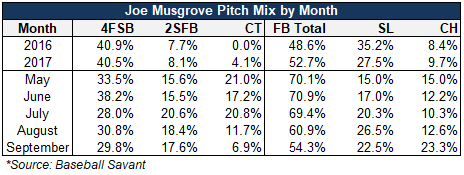
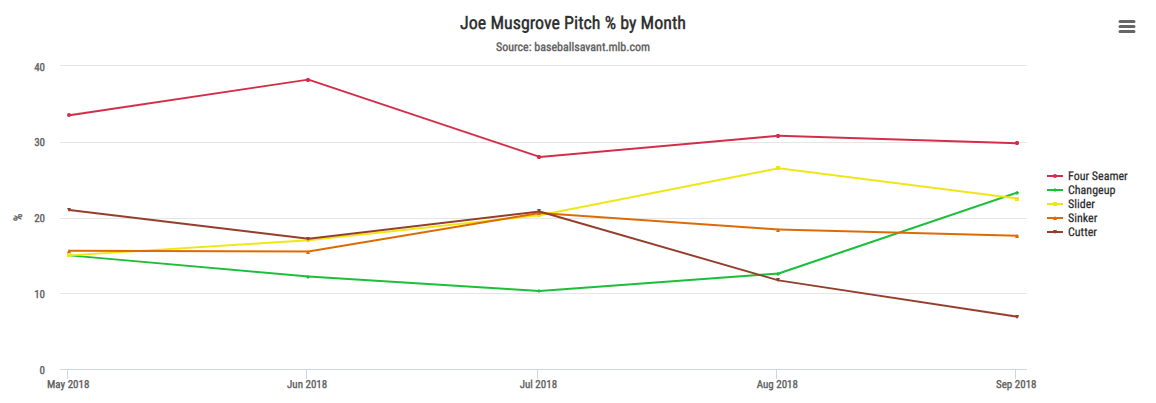

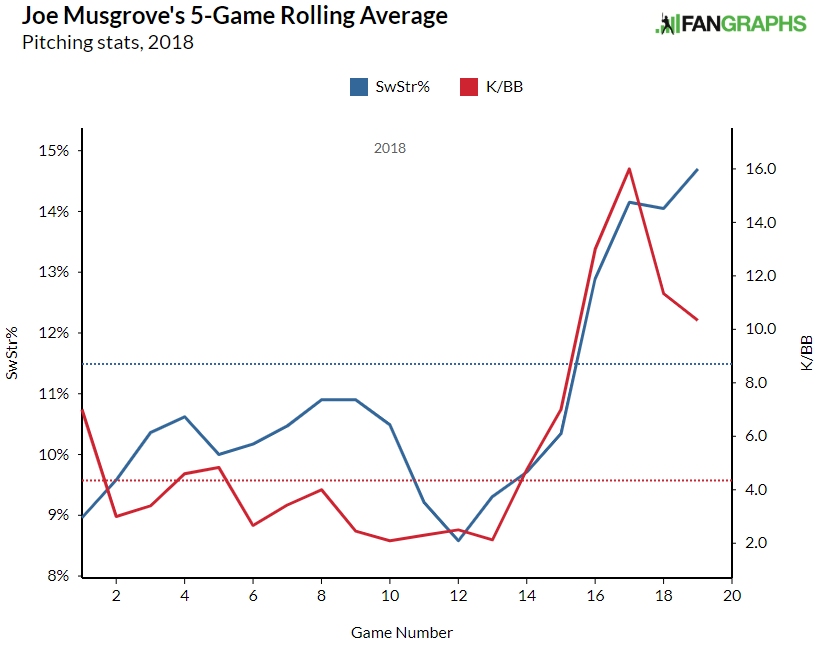

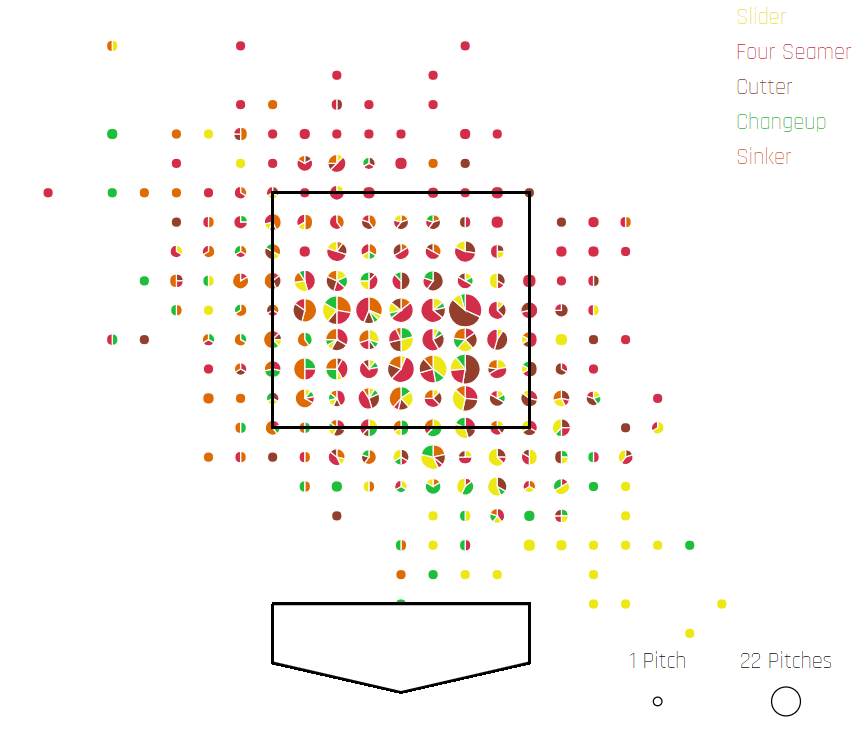
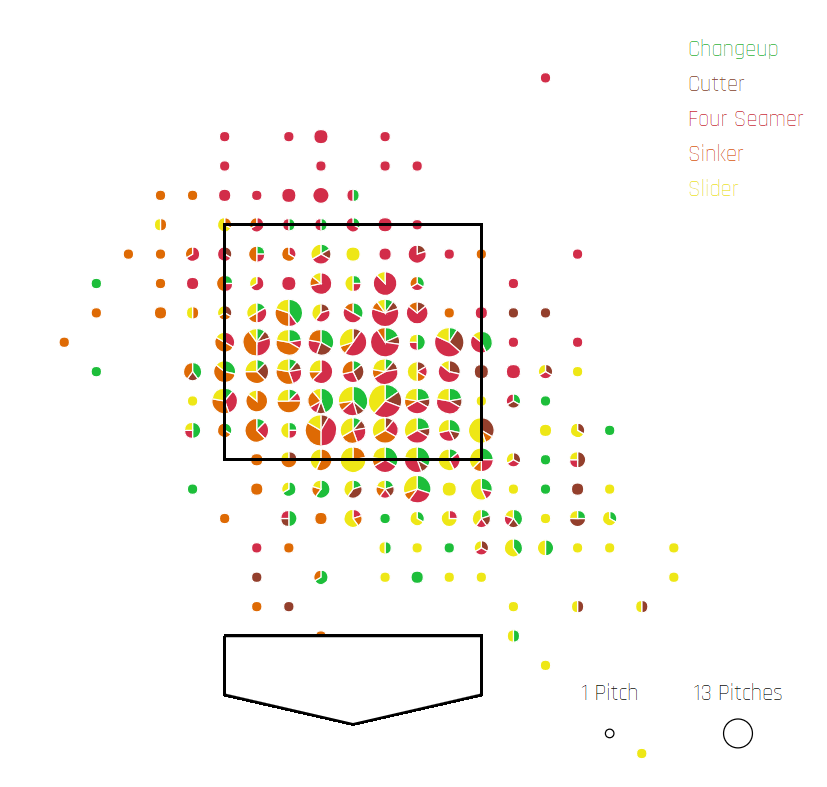
Great article, Nick. I’m curious which of his pitches hitters were squaring up in the second half. I’d argue he should work on burying those sliders and changeups out of the zone more, especially with those whiff rates. Might see the BB/9 rate go up but hopefully the dong/9 rate go down.
Thanks for the comment Dave! Below are the exit velocities for different pitches from Aug 6 onwards (2SFB isn’t pulling right now for some reason):
4SFB – 90.1 (43 BBE)
CT – 91.9 (14 BBE)
SL – 84.7 (29 BBE)
CH – 79.4 (24 BBE)
His four seamer was getting hit harder, but not to a ridiculous degree. The league average exit velo on four seamers is 89.2. The cutter did seem problematic compared to league average of 86.4. Not surprisingly that cutter was the pitch that saw the biggest decrease in use. His slider and change look great by the exit velo metrics and you could argue he should be throwing them more.
Quick question – where do you find dong/9 rate? Is that on Fangraphs?
Well-written and thorough. Just to follow-up, what would you say to the naysayers looking at his high ERA in the second half and avoiding him in drafts? Bad luck or something more? And who is a pitcher that you think he’s better than that would surprise me?
That’s a good question. I got comfortable with the ERA a couple ways:
First, his average exit velo after Aug 6 was 87.1 compared to 86.7 prior. His barrel rate was also 5.5% post compared to 4.8% prior. So there were modest increases in batted ball quality but nothing that would indicate he was getting hit around.
Second, his 57 LOB% was absurdly low. The lowest a pitcher will go over the long haul there is high 60% range.
The combination of those two things says that his ERA was more the result of sequencing luck than anything else.
In terms of a pitcher to compare him to I’m thinking Miles Mikolas. I doubt Musgrove is better, but they might be fairly comparable, and I’d rather take Musgrove in round 23 than Mikolas in round eight (with that said, Mikolas had his own late season improvement worth discussing).
I’m considering Musgrave for my dynasty 12 cat league. My rotation is Kluber, Snell, Corbin, E-rod, Flaherty, Castillo, Pivetta, and Jimmy Nelson. Adding Musgrove I’m curious if he could be a strong streaming option or maybe has the potential to be a top 25 pitcher?
Thanks for your comment Brian!
You obviously have a strong rotation to start with, but I prefer Musgrove to the likes of Pivetta, Nelson and Rodriguez.
Musgrove’s finish to 2018 was so strong from a peripheral standpoint that I think he will definitely be on most rosters by early season 2019, making it unlikely that he’ll be available as a streamer. He certainly has the potential to be a top 25 pitcher with the K/BB and SwStk rates he was putting up in late 2018.
Thank you for the feedback Nick on Musgrove and my pitching staff. I just started really using pitcher list and reading your articles along with the other doing deep posts has moved my team from 9th to 3rd in a dynasty league I joined last year. I will interested to hear your takes on upcoming players throughout the 2019 season and beyond.
This is a solid piece, love the insight into Joe’s pitch mix and the results it’s produced. Got any other pitcher pieces like this coming? Perhaps a Matt Strahm piece??